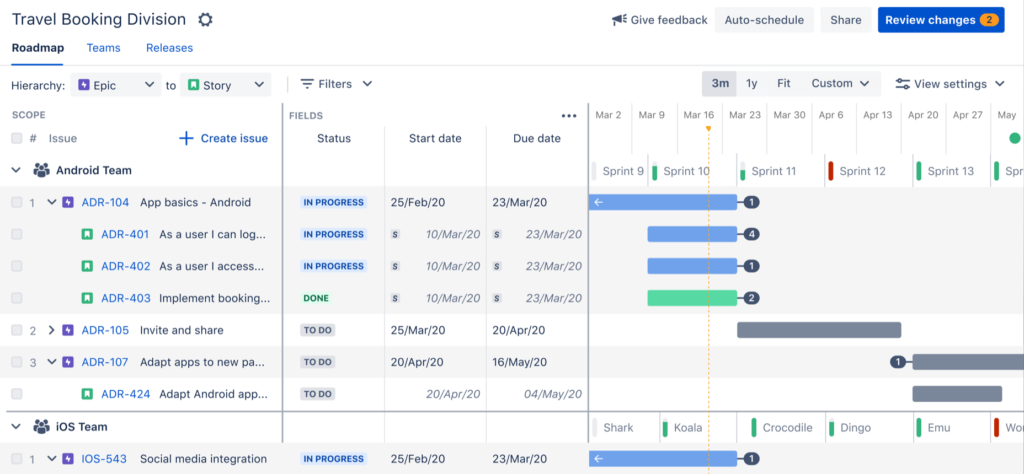Agile methodologies have taken the world by storm. Teams love the flexibility, faster delivery, and increased collaboration that Agile offers. But scaling Agile to the enterprise level? That’s where things get tricky. Many companies struggle to break free from traditional hierarchies and mindsets, leading to Agile initiatives getting lost in a sea of bureaucracy.
The Agile Essentials
Before we dive into scaling, let’s recap the Agile basics. The Agile Manifesto, published in 2001, introduced a new way of working. Instead of rigid, sequential plans (waterfall), Agile emphasizes iterative progress, frequent feedback, and adapting to change. This means:
Why Agile Scaling is Hard
Scaling Agile across an entire organization requires a significant shift in culture and mindset. Here’s why many companies stumble:
Scaling Agile Successfully
To truly reap the benefits of Agile at scale, companies need to address these challenges head-on:
Organizing for Scale: Why Clarity Matters
While Agile thrives on close collaboration, scaling it across a large organization requires a more structured approach. Simply put, you can’t rely solely on personal relationships when you have hundreds or thousands of employees.
Many Agile frameworks use Dunbar’s number (150) as a guide for team size, recognizing the cognitive limits of maintaining close relationships. However, most enterprises far exceed this number. Therefore, it’s crucial to establish a clear organizational taxonomy – a well-defined structure that outlines team responsibilities and capabilities.
Think of it this way: everyone should know who’s doing what. As USAA COO Carl Liebert puts it, you should be able to ask, “Who owns X?” and get a clear, confident answer from the responsible team. This eliminates confusion, streamlines decision-making, and ensures accountability.
There are various ways to structure teams at scale, such as by feature area (like in the Spotify model), by product, or by customer journey. The key is to find an organizational design that aligns with your company’s values and priorities, enabling efficient collaboration and value delivery.
Empowering Teams: The Foundation of Agile at Scale
Agile thrives on trust and autonomy. As the Agile Manifesto states, “motivated teams are more likely to deliver their best work.” This principle becomes even more critical when scaling Agile.
However, traditional top-down management practices often undermine autonomy. Instead of empowering teams, organizations may inadvertently create rigid structures and processes that stifle innovation and erode trust.
To avoid this pitfall, leaders should focus on setting clear strategic priorities and goals. Then, trust your teams to determine the best way to achieve those goals. Empower product owners to collaborate closely with customers and make informed decisions. This approach fosters a sense of ownership and allows teams to leverage their expertise and creativity.
Remember, Agile is about adapting to change. Be prepared to adjust priorities and goals as needed, maintaining a flexible and responsive approach to meet evolving customer needs.
Scaling Agile: A Journey of Transformation
Successfully scaling Agile requires a fundamental shift in mindset and culture. It’s not just about adopting new processes; it’s about embracing the core values of Agile throughout the organization.
Teams, leaders, and organizational structures must evolve in unison, always aligning with the company’s overall purpose. This means fostering a culture of collaboration, trust, and continuous improvement.
Crucially, no team should be left behind in this transformation. Every part of the organization needs to embrace Agile principles to ensure everyone is moving in the same direction. Otherwise, you risk creating internal friction and hindering the progress of your Agile journey.
Agile Frameworks: Your Roadmap to Success
Scaling Agile doesn’t have to be a journey into the unknown. Several frameworks can guide your transformation:
Scaled Agile Framework (SAFe): A Structured Approach to Enterprise Agility
The Scaled Agile Framework (SAFe) provides a comprehensive blueprint for implementing Lean and Agile practices at the enterprise level. It offers a set of organizational and workflow patterns that help align strategy with execution, enabling large organizations to deliver value more effectively.
SAFe is built on seven core competencies of the Lean enterprise and introduces concepts like Program Increments (PIs) and Agile Release Trains (ARTs) to coordinate work across multiple teams. While SAFe emphasizes alignment and planning, it’s sometimes considered less “purely Agile” than other frameworks due to its more structured, top-down approach.
Large-Scale Scrum (LeSS): Scaling Simplicity
LeSS takes the principles of Scrum and applies them to the enterprise level, with a focus on minimalism. Instead of adding complexity, LeSS aims to reduce it. Teams continue to use Scrum boards, sprints, and ceremonies, but they might share a single product backlog and sprint cadence to improve coordination.
A key role in LeSS is the Area Product Owner, who provides guidance and oversight across multiple Scrum teams. By keeping rules and guidelines to a minimum, LeSS empowers teams to self-manage and deliver value efficiently, while minimizing waste and unnecessary overhead.
The Spotify Model: Agile-at-Scale in Action
More than a rigid framework, the Spotify Model is a compelling example of how a company successfully scaled Agile. Introduced in a 2012 whitepaper by Henrik Kniberg and Anders Ivarsson, it highlights Spotify’s unique approach to Agile at scale, emphasizing autonomy, culture, and network-based collaboration.
At its core, the Spotify Model empowers individuals and teams. Teams have the freedom to choose their preferred Agile framework and organize themselves into “Squads” focused on specific features or missions. To foster knowledge sharing and cross-team collaboration, individuals with similar skills can join “Chapters” and “Guilds” based on their interests and expertise. These squads are then grouped into “Tribes” to tackle larger initiatives.
While the Spotify Model offers valuable insights, it’s important to remember that it was tailored to Spotify’s specific needs and culture. It’s not a one-size-fits-all solution, but rather an inspiring example of how to adapt Agile principles at scale.
Don’t Just Copy, Adapt!
Every organization is unique. Find a framework (or combination of frameworks) that aligns with your specific needs and culture. Be prepared to adapt and evolve your approach over time.
Jira: Your Agile Partner at Scale
When it comes to scaling Agile, Atlassian’s Jira suite stands out as a leading solution. With a proven track record and a wide range of tools, Jira supports organizations of all sizes in their Agile journey.
Jira Software, used by thousands of teams worldwide, provides a robust foundation for Agile work management. Its flexibility allows teams to adopt various Agile methodologies, while features like Advanced Roadmaps offer portfolio-level visibility and planning.
For larger enterprises with complex needs, Jira Align offers a dedicated platform for scaling Agile frameworks like SAFe, LeSS, and more. Jira Align provides out-of-the-box support for popular frameworks, incorporating their terminology and reporting structures, and integrates seamlessly with existing Jira deployments.
However, even without Jira Align, the Atlassian ecosystem provides a powerful solution for scaling Agile. Jira Software, Confluence, Bitbucket, and Jira Service Management can be combined to create a customized platform that empowers teams, enhances collaboration, and provides leadership with the insights they need to manage at scale.
Key benefits of Atlassian for scaling Agile:
Whether you’re just starting your Agile journey or looking to optimize your existing practices, Atlassian’s Jira provides the tools and flexibility to scale Agile effectively.
Jira: Empowering Teams While Maintaining Alignment
Jira Software provides the flexibility to support various Agile styles, from Kanban and Scrum to hybrid approaches like Scrumban. This allows teams to choose the method that best suits their needs and preferences.
Jira’s issue hierarchies enable effective management of work at different levels. Leaders can track long-term initiatives and programs, while teams focus on features and epics. Advanced Roadmaps provides a clear overview of planned work, with the ability to drill down for more detailed information. Effort estimation is streamlined across the organization, making it easier to allocate resources and plan strategically.

Beyond software development, Jira’s capabilities extend to other business functions. Jira Work Management supports marketing, HR, finance, and more, while Jira Service Management integrates service desk operations with the rest of the organization. This cross-functional approach ensures alignment and collaboration across all teams.
If you’re unsure whether Jira meets your specific needs, Oxalis can help. We’ll assess your Agile maturity and create a tailored transformation roadmap to guide your implementation.
Atlassian Cloud: Agile in the Fast Lane
Atlassian is heavily invested in cloud technology, recognizing its ability to deliver value quickly and enable rapid adoption of best practices. Their streamlined cloud offerings — Cloud Standard, Cloud Premium, and Data Center (for on-premises needs) — provide flexible options for organizations of all sizes and compliance requirements.
This focus on cloud demonstrates Atlassian’s commitment to providing cutting-edge Agile tools with enhanced accessibility and scalability. To learn more about the different cloud options and choose the best fit for your organization, check out our white paper: “Atlassian Compliant Cloud vs Data Center.”
Oxalis: Your Partner in Scaling Agile with Atlassian
Scaling Agile successfully requires a deep understanding of your organization’s unique structure, culture, and existing tools. It’s a journey of continuous improvement, involving testing, measuring, learning, and adapting.
Whether you’re new to Atlassian or already using their products, Oxalis can help you navigate this journey. We’ll work closely with your team to design a tailored solution that meets your specific needs. Our services include:
If you’re looking to migrate to Atlassian or consolidate existing tools, our cohort-based migration approach has a proven track record of success. We’ll help you seamlessly transition to a unified platform, enabling better collaboration and efficiency across your organization.
Taking the First Steps to Agile-at-Scale
Scaling Agile is a journey, not a destination. Here are some key starting points:
While the full benefits of Agile-at-scale may take time to realize, you’ll likely see positive changes early on. By investing in Agile best practices now, you’re building a foundation for adaptability and responsiveness, enabling your organization to thrive in the face of changing market dynamics and seize new opportunities.






